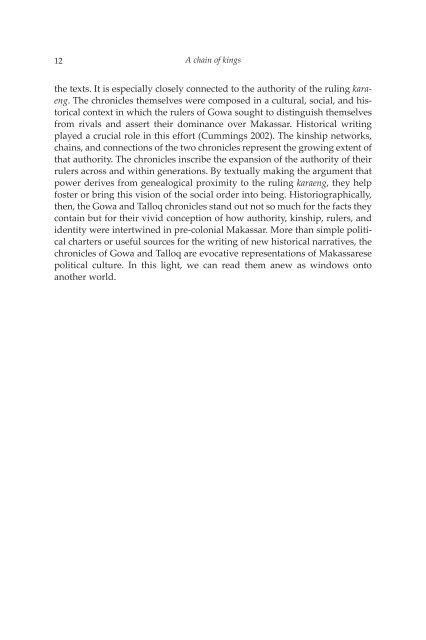A CHAIN OF KINGS - Books and Journals
A CHAIN OF KINGS - Books and Journals
A CHAIN OF KINGS - Books and Journals
Create successful ePaper yourself
Turn your PDF publications into a flip-book with our unique Google optimized e-Paper software.
12<br />
A chain of kings<br />
the texts. It is especially closely connected to the authority of the ruling karaeng.<br />
The chronicles themselves were composed in a cultural, social, <strong>and</strong> historical<br />
context in which the rulers of Gowa sought to distinguish themselves<br />
from rivals <strong>and</strong> assert their dominance over Makassar. Historical writing<br />
played a crucial role in this effort (Cummings 2002). The kinship networks,<br />
chains, <strong>and</strong> connections of the two chronicles represent the growing extent of<br />
that authority. The chronicles inscribe the expansion of the authority of their<br />
rulers across <strong>and</strong> within generations. By textually making the argument that<br />
power derives from genealogical proximity to the ruling karaeng, they help<br />
foster or bring this vision of the social order into being. Historiographically,<br />
then, the Gowa <strong>and</strong> Talloq chronicles st<strong>and</strong> out not so much for the facts they<br />
contain but for their vivid conception of how authority, kinship, rulers, <strong>and</strong><br />
identity were intertwined in pre-colonial Makassar. More than simple political<br />
charters or useful sources for the writing of new historical narratives, the<br />
chronicles of Gowa <strong>and</strong> Talloq are evocative representations of Makassarese<br />
political culture. In this light, we can read them anew as windows onto<br />
another world.









![Am HaSefer [Volk des Buches] - Books and Journals](https://img.yumpu.com/20648352/1/174x260/am-hasefer-volk-des-buches-books-and-journals.jpg?quality=85)







